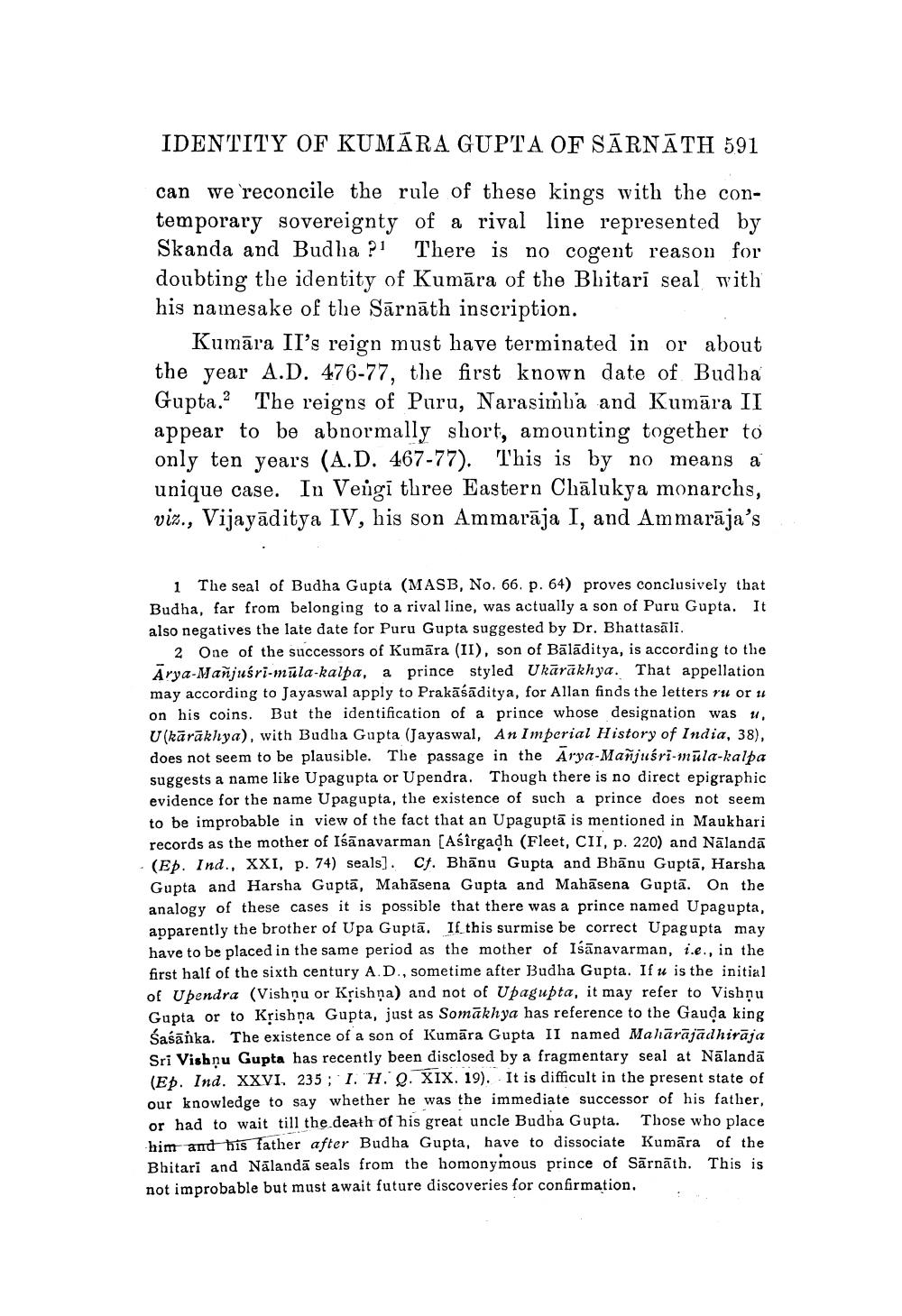________________
IDENTITY OF KUMĀRA GUPTA OF SĀRNĀTH 591
can we reconcile the rule of these kings with the contemporary sovereignty of a rival line represented by Skanda and Budha ?1 There is no cogent reason for doubting the identity of Kumāra of the Bhitari seal with his namesake of the Sārnāth inscription.
Kumāra II's reign must have terminated in or about the year A.D. 476-77, the first known date of Budha Gupta.? The reigns of Puru, Narasimha and Kumāra II appear to be abnormally short, amounting together to only ten years (A.D. 467-77). This is by no means a unique case. In Veigi three Eastern Chālukya monarchs, viz., Vijayāditya IV, his son Ammarāja I, and Ammarāja's
1 The seal of Budha Gupta (MASB, No. 66. p. 64) proves conclusively that Budha, far from belonging to a rival line, was actually a son of Puru Gupta. It also negatives the late date for Puru Gupta suggested by Dr. Bhatta sāli.
2 One of the successors of Kumāra (II), son of Bālāditya, is according to the Arya-Manjusri-müla-kalpa, a prince styled Ukārākhya. That appellation may according to Jayaswal apply to Prakāśāditya, for Allan finds the letters ru or 11 on his coins. But the identification of a prince whose designation was u, Ukārākhya), with Budha Gupta (Jayaswal, An Imperial History of India, 38), does not seem to be plausible. The passage in the Arya-Manjusri-müla-kalba suggests a name like Upagupta or Upendra. Though there is no direct epigraphic evidence for the name Upagupta, the existence of such a prince does not seem to be improbable in view of the fact that an Upaguptā is mentioned in Maukhari records as the mother of Iśānavarman (Asîrgadh (Fleet, CII, p. 220) and Nālanda - (Ep. Ind., XXI, p. 74) seals). Cf. Bhānu Gupta and Bhānu Guptā, Harsha
Gupta and Harsha Guptā, Mahāsena Gupta and Mahāsena Guptā. On the analogy of these cases it is possible that there was a prince named Upagupta, apparently the brother of Upa Guptā. If this surmise be correct Upagupta may have to be placed in the same period as the mother of Isānavarman, i.e., in the first half of the sixth century A.D., sometime after Budha Gupta. If u is the initial of Upendra (Vishņu or Krishna) and not of Upagupta, it may refer to Vishnu Gupta or to Krishna Gupta, just as Somākhya has reference to the Gauda king Śaśānka. The existence of a son of Kumāra Gupta II named Mahārājādhiraja Sri Vishņu Gupta has recently been disclosed by a fragmentary seal at Nalanda (Ep. Ind. XXVI. 235 ; 1. H. 9. XIX. 19). It is difficult in the present state of our knowledge to say whether he was the immediate successor of his father, or had to wait till the death of his great uncle Budha Gupta. Those who place him and his father after Budha Gupta, have to dissociate Kumāra of the Bhitari and Nālandā seals from the homonymous prince of Sārnāth. This is not improbable but must await future discoveries for confirmation,




